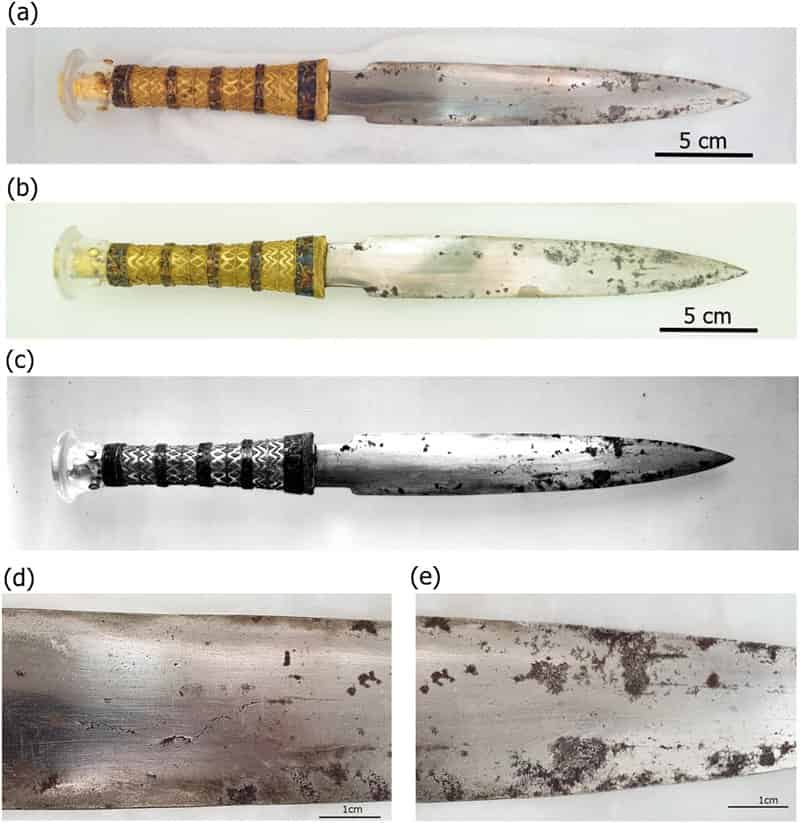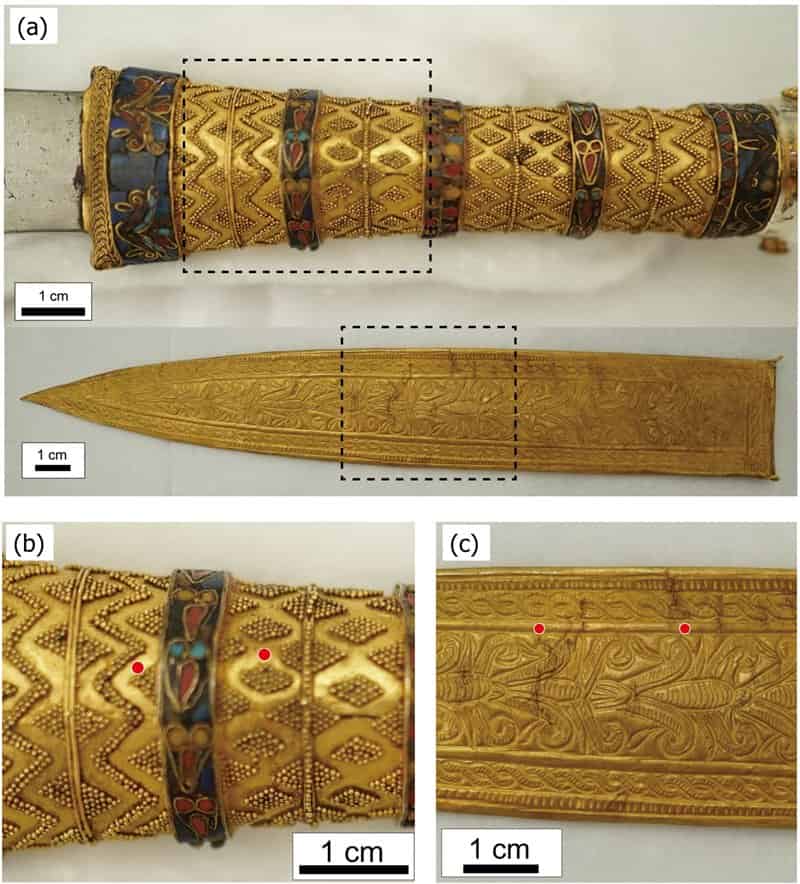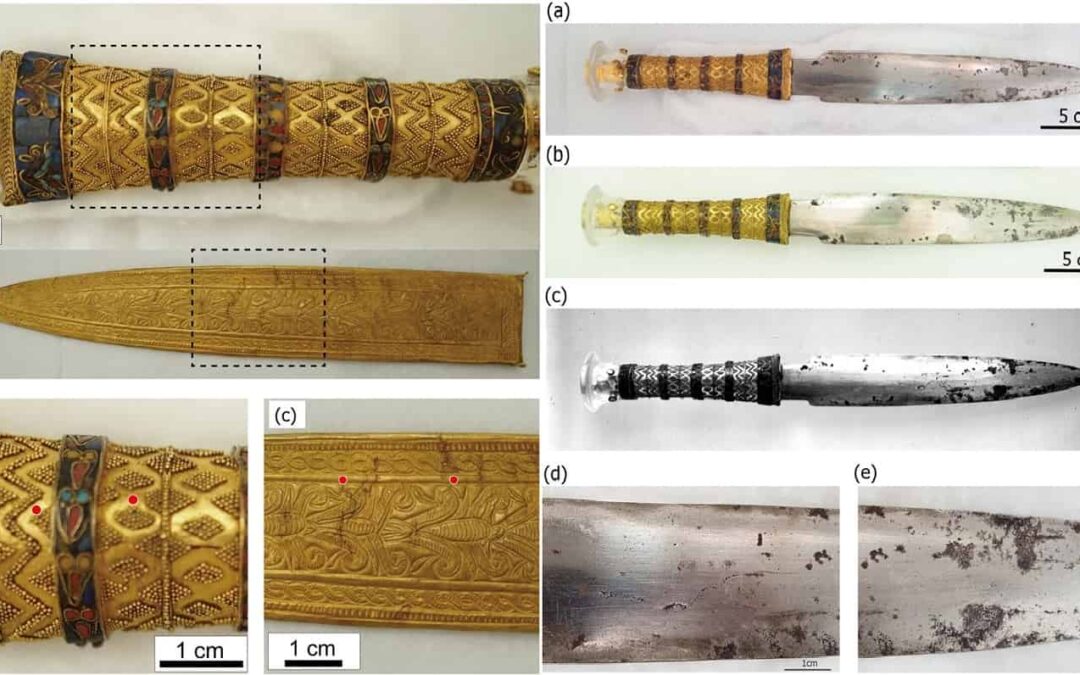“Next to the kilt, alongside the right thigh, and, in my opinion, part of the same girdle as the kilt, there lay a unique and extraordinary dagger, sheathed in a gold scarab.
Its hilt was made of granulated gold, embellished at intervals with bands of colored rock crystal.
However, the most astounding and exceptional feature of this beautiful weapon is that its blade was crafted from iron, still gleaming and steel-like.”
This description reflects the astonishment of Egyptologist Howard Carter, who discovered Tutankhamun’s tomb in the Valley of the Kings in 1922. He found the famous meteoric iron dagger among the bandages covering the pharaoh’s mummy, positioned there as if it were one of his most prized possessions.
This extraordinary weapon, discovered in Tutankhamun’s tomb alongside another similar one (though with a blade forged in gold), measures almost 35 centimeters in length. Its iron blade contains 11 percent nickel and 0.6 percent nickel cobalt, indicating its origin from a meteorite.
Indeed, the extraterrestrial origin of the metal used to craft the blade of this unique dagger was confirmed in 2016 through a study of its chemical composition.
However, this confirmation didn’t answer all the questions surrounding an object with such distinctive characteristics: How it was forged and where.
A recent study conducted by a team of researchers from the Chiba Institute of Technology in Japan, led by Takafumi Matsui, in collaboration with Egyptian experts, has reaffirmed the extraterrestrial origin of Tutankhamun’s famous iron dagger. The study also found evidence indicating it was forged outside of Egypt, as previously suggested.
According to the study, published in the journal Meteorics & Planetary Science, an analysis of the distribution of nickel on the dagger’s surface—performed by directing non-destructive X-rays at the blade—revealed that the metal was heated at a low temperature, between 800 and 950 degrees.
This has been proven through the existence of the so-called “Widmanstatten structures,” elongated crystals that form a cross-stitch-shaped pattern. These structures appear in the nickel present in meteoric iron when temperatures reach a certain point and vanish when they reach or exceed 1,000 degrees.
The presence of this pattern also suggests that the meteorite iron used for the blade belonged to a group of ferric meteorites known as octahedrites. The analysis has also documented the presence of sulfur, zinc, and chlorine.
A Gift for the Pharaoh?
So, if the blade was not forged in Egypt, where did it originate? Could it have been a diplomatic gift? If so, from whom?
Answering these unknowns isn’t straightforward, but researchers believe that the dagger’s origin can be traced through the study of diplomatic correspondence from the time, specifically the “Amarna letters.” These letters constitute an archive of clay tablets discovered in Amarna, the capital founded by Pharaoh Akhenaten (1353-1336 BC).
Among this correspondence are missives sent by foreign vassal monarchs to Amenhotep III (1390-1353 BC) and his son Akhenaten.
Research has yielded an interesting detail in this regard. An iron dagger is mentioned in one of these letters that Amenhotep III, Tutankhamun’s grandfather, received as a gift from King Tushratta of Mitanni.
This piece of information is valuable since, according to the researchers, “the technology of iron processing and the use of lime plaster were already prevalent in the Mittanni region and the Hittite region at that time. The Amarna letters could serve as evidence suggesting that Tutankhamun’s iron dagger might have been brought from outside Egypt,” they commented in the study.
Additionally, “the high quality of the knife indicates that the ability to work meteorite iron was already well established at that time,” the researchers concluded.








